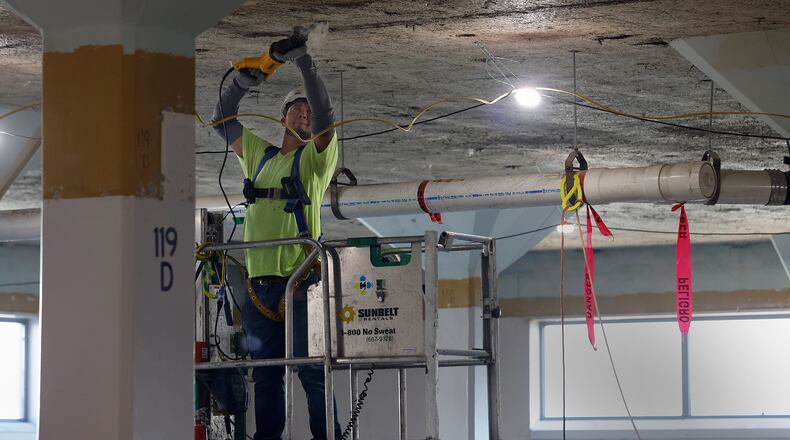“It’s a huge effort, and it’s just begun,” said Michael Zanoli, an engineer involved with the project.
The heart of the Air Force’s huge logistics mission, AFMC is responsibile for equipping and sustaining the service. It’s a world-spanning organization of some 89,000 people working with $72 billion of budget authority. The sole four-star general stationed at Wright-Patterson — Gen. Duke Z. Richardson, commander of AFMC — works in these buildings.
A $118 million contract for the construction work was awarded to Messer Construction in June 2023. Messer is working with at least ten subcontractors, said Abby Markworth, a U.S. Army Corps of Engineers project engineer. On any given day, perhaps 30 to 50 construction employees may be at work on the site.
The buildings were first constructed at about the same time as the Pentagon in Arlington, Va. Outdated systems are getting a wide-ranging makeover, including mechanical, electrical, and communication systems. The project is addressing stubborn water intrusion in the basement, and a deteriorating stormwater system is getting attention.
This is a long-term project — very long-term.
There are three phases for one of the buildings, building 262 (covering 538,170 square feet), with the first phase expected to conclude in 2032, and the second phase starting in 2028. The third phase is slated to begin in 2030.
Building 266′s renovation will continue beyond the year 2030, with additional phases planned beyond that.
A good chunk of building 262 is being prepared for a new Army and Air Force Exchange Service-run food court. A planned community area will include a Wright-Patterson Credit Union branch, a barber shop, and a laundry and dry cleaning facility. The dining area will have electrical outlets and wi-fi so it can be used as a meeting area.
Phase one of construction is the all-important foundation for everything that follows.
“We’ve got to get this phase right,” Zanoli said. “Everything depends on getting this phase right.”
Building 262 was built in 1942, with building 266 following in the mid-1960s. Despite partial renovations and updates over the years, the building has not had a comprehensive renovation, AFMC said in a recent account of the construction project. The only significant update to the complex since original construction was in 1995 to modernize air handling units, the command said.
One requirement that makes the project so complex: The work happening here can’t be interrupted.
“A lot of the work to date has been isolating the construction space from the occupied space,” Markworth said. “They have built a construction barrier on the first floor pretty much along this entire line to do that, isolating existing electrical and communication (infrastructure), as well as just a physical barrier to protect this building’s occupants.”
Amy Daniels, civil engineering program manager for the AFMC headquarters complex, estimated that at least 1,200 to 1,300 workers have been temporarily displaced or shifted to new locations, on and off base, to make room for the construction.
AFMC spokespeople declined to say where off base some workers have been moved, but the Dayton Daily News has reported that some workers had begun to make a home in the Miami Valley Research Park beginning in late 2022.
Telework capability — what the Air Force calls the ability to work from home or other remote locations — has helped ease that transition.
“It’s certainly an enhancement, from a quality-of-life perspective,” said Derek Kaufman, a spokesman for AFMC. “There are still some noise intrusions, as you can tell, that go with the territory with a construction project of this scope.”
When workers return, they’ll find a work space with a more efficient heating, ventilation and air-conditioning system, LED lighting and other amenities.
About the Author



